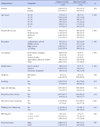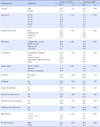Abstract
Purpose
The purpose of this study is to investigate the prevalence of metabolic syndrome and its components and to examine the related factors in urban and rural community, South Korea.
Methods
The data from the 5th Korea National Health and Nutrition Examination Survey (KNHANES-V) conducted in 2010 were utilized in this study. The subjects were 5,760 adults 20 years or over. The data were consisted with health survey questionnaire and health examination. χ2-test and logistic regression was used for the analysis SAS 9.3 applying sampling weights.
Results
The prevalence of metabolic syndrome based on the latest definition proposed the joint scientific meeting was 23.4% and 29.0% respectively in urban and rural community. Rural community showed higher prevalence of abdominal obesity (29.9% vs 38.5%), elevated blood pressure (31.3% vs 38.5%), elevated blood glucose (24.3% vs 28.4%) than urban community. The related factors were age, marital status, high risk drinking, obesity in urban community and age, marital status high risk drinking, severe physical activity, obesity in rural community.
Figures and Tables
Table 2
Comparison of Age-adjusted Prevalences of Metabolic Syndrome Components in Urban and Rural Community

References
1. Abdul-Rahim HF, Husseini A, Bjertness E, Giacaman R, Gordon NH, Jervell J. The metabolic syndrome in the West Bank population: An urban-rural comparison. Diabetes care. 2001; 24(2):275–279. DOI: 10.2337/diacare.24.2.275.
2. Alberti K, Eckel RH, Grundy SM, Zimmet PZ, Cleeman JI, Donato KA, et al. Harmonizing the metabolic syndrome: A joint interim statement of the International Diabetes Federation Task Force on Epidemiology and Prevention; National Heart, Lung, and Blood Institute; American Heart Association; World Heart Federation; International Atherosclerosis Society; and International Association for the Study of Obesity. Circulation. 2009; 120(16):1640–1645. DOI: 10.1161/CIRCULATIONAHA.109.192644.
3. Arai H, Yamamoto A, Matsuzawa Y, Saito Y, Yamada N, Oikawa S, et al. Prevalence of metabolic syndrome in the general Japanese population in 2000. J Atheroscler Thromb. 2006; 13(4):202–208.

4. Beltrán-Sánchez H, Harhay MO, Harhay MM, McElligott S. Prevalence and trends of metabolic syndrome in the adult U.S. population, 1999-2010. J Am Coll Cardiol. 2013; 62(8):697–703. DOI: 10.1016/j.jacc.2013.05.064.

5. Butler J, Rodondi N, Zhu Y, Figaro K, Fazio S, Vaughan D, et al. Metabolic syndrome and the risk of cardiovascular disease in older adults. J Am Coll Cardiol. 2006; 47(8):1595–1602. DOI: 10.1016/j.jacc.2005.12.046.

6. Gami AS, Witt BJ, Howard DE, Erwin PJ, Gami LA, Somers VK, et al. Metabolic syndrome and risk of incident cardiovascular events and death: A systematic review and meta-analysis of longitudinal studies. J Am Coll Cardiol. 2007; 49(4):403–414.
7. Grundy SM. Metabolic syndrome pandemic. Arterioscler Thromb Vasc Biol. 2008; 28(4):629–636. DOI: 10.1161/ATVBAHA.107.151092.
8. Gu D, Reynolds K, Wu X, Chen J, Duan X, Reynolds RF, et al. Prevalence of the metabolic syndrome and overweight among adults in China. Lancet. 2005; 365(9468):1398–1405.

9. Joens-Matre RR, Welk GJ, Calabro MA, Russell DW, Nicklay E, Hensley LD. Rural-urban differences in physical activity, physical fitness, and overweight prevalence of children. J Rural Health. 2008; 24(1):49–54. DOI: 10.1111/j.1748-0361.2008.00136.x.

10. Khang YH. Different logivity by village. In : Lee CG, editor. Chasing health inequality in Korea: A report for making it social issues. Seoul: Publishing Company Meem;2007. p. 67–79.
11. Kozan O, Oguz A, Abaci A, Erol C, Ongen Z, Temizhan A, et al. Prevalence of the metabolic syndrome among Turkish adults. Eur J Clin Nutr. 2007; 61(4):548–553. DOI: 10.1038/sj.ejcn.1602554.

12. Lee MS. Health inequalities among Korean adults. Korean J Sociol. 2005; 39(6):183–209.
13. Lim H, Nguyen T, Choue R, Wang Y. Sociodemographic disparities in the composition of metabolic syndrome components among adults in South Korea. Diabetes care. 2012; 35(10):2028–2035. DOI: 10.2337/dc11-1841.

14. Lim S, Jang H, Lee H, Kim K, Park C, Cho N. A rural-urban comparison of the characteristics of the metabolic syndrome by gender in Korea: the Korean Health and Genome Study(KHGS). J Endocrinol Invest. 2006; 29(4):313–319.
15. Lim S, Shin H, Song JH, Kwak SH, Kang SM, Yoon JW, et al. Increasing prevalence of metabolic syndrome in Korea: The Korean National Health and Nutrition Examination Survey for 1998-2007. Diabetes Care. 2011; 34(6):1323–1328.
16. Ministry of Health and Welfare. Korea Center for Disease Control and Prevention. 2010 National health statistics: Report of the first year of the fifth National Health and Nutrition Survey in 2010. Seoul: Ministry of Health and Welfare;2011.
17. Ministry of Health and Welfare. Korea Center for Disease Control and Prevention. The guidelines for using raw data of the fifth Korea National Health and Nutrition Examination Survey, 2010 (KNHANES V-1, 2010). Seoul: Ministry of Health and Welfare;2011.
18. Ntandou G, Delisle H, Agueh V, Fayomi B. Abdominal obesity explains the positive rural urban gradient in the prevalence of the metabolic syndrome in Benin, West Africa. Nutr Res. 2009; 29(3):180–189. DOI: 10.1016/j.nutres.2009.02.001.
19. Park E. A Comparative study of youth health risk behaviors by region: Focused on metropolitan areas, medium sized and small city areas, and rural areas. J Korean Acad Nurs. 2010; 40(1):14–23. DOI: 10.4040/jkan.2010.40.1.14.

20. Park E, Choi SJ, Lee HY. The prevalence of metabolic syndrome and related risk factors based on the KNHANES V 2010. J Agric Med Community Health. 2013; 38(1):1–13. DOI: 10.5393/JAMCH.2013.38.1.001.

21. Park HS, Oh SW, Cho SI, Choi WH, Kim YS. The metabolic syndrome and associated lifestyle factors among South Korean adults. Int J Epidemiol. 2004; 33(2):328–336. DOI: 10.1093/ije/dyh032.

22. Park YW, Zhu S, Palaniappan L, Heshka S, Carnethon MR, Heymsfield SB. The metabolic syndrome: Prevalence and associated risk factor findings in the US population from the third National Health and Nutrition Examination Survey, 1988-1994. Arch Intern Med. 2003; 163(4):427–436. DOI: 10.1001/archinte.163.4.427.
23. Prabhakaran D, Chaturvedi V, Shah P, Manhapra A, Jeemon P, Shah B, et al. Differences in the prevalence of metabolic syndrome in urban and rural India: A problem of urbanization. Chronic Illn. 2007; 3(1):8–19. DOI: 10.1177/1742395307079197.

24. Sarkar S, Das M, Mukhopadhyay B, Chakrabarti C, Majumder PP. High prevalence of metabolic syndrome & its correlates in two tribal populations of India & the impact of urbanization. Indian J Med Res. 2006; 123(5):679–686.
25. Ulasi II, Ijoma CK, Onodugo OD. A community-based study of hypertension and cardio-metabolic syndrome in semi-urban and rural communities in Nigeria. BMC Health Serv Res. 2010; 10(1):71. DOI: 10.1186/1472-6963-10-71.

26. Weng X, Liu Y, Ma J, Wang W, Yang G, Caballero B. An urban-rural comparison of the prevalence of the metabolic syndrome in Eastern China. Public Health Nutr. 2007; 10(02):131–136. DOI: 10.1017/S1368980007226023.

27. Zyl S, Merwe LJ, Walsh CM, Groenewald AJ, Rooyen FC. Risk-factor profiles for chronic diseases of lifestyle and metabolic syndrome in an urban and rural setting in South Africa. Afr J Prim Health Care Fam Med. 2012; 4(1):1–10. DOI: 10.4102/phcfm.v4i1.346.





 PDF
PDF ePub
ePub Citation
Citation Print
Print





 XML Download
XML Download